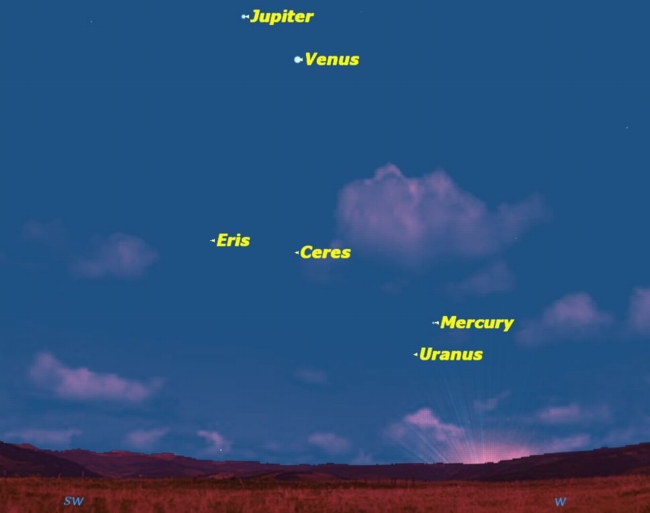Jupiter and Venus Set for Night Sky Rendezvous

Skywatchers have been watching with anticipation lately as Jupiter draws close to Venus in the evening twilight sky.
This week, as Venus and Jupiter draw close for a March 15 conjunction, they are joined by the planet Mercury somewhat lower in the sky. Observers with binoculars may also be able to spot Uranus, just below Mercury, and dwarf planet Ceres nearby. Another dwarf planet, distant Eris, is also close, but too faint to be seen through amateur telescopes.
The sky map of Jupiter and Venus for this story shows how the planets and other solar system objects appear in the night sky. Jupiter and Venus are currently the brightest of the planets, but present some remarkable contrasts to anyone with a small telescope.
Although Jupiter is far larger than Venus in actual size, it is much farther from the sun, and so is much fainter than Venus in brightness. Because Jupiter's orbit is farther from the sun than Earth's, it appears to us almost 100 percent illuminated. Venus is closer to the sun than Earth, and off to one side, so it is currently 61 percent illuminated, looking like our moon when it's one day past first quarter. [Telescopes for Beginners]
Through a telescope, Jupiter appears almost twice as large as Venus, though that will change as Venus swings closer to Earth over the next few months. When Venus is closest to Earth on June 5, it will appear three times larger than it is at present. At that time, it will pass between Earth and the sun, appearing as a tiny black spot against the sun. This Venus transit occurs less than twice a century. The 2012 transit of Venus occurs on June 5 will not be repeated until the year 2117.
The atmospheres of the two planets are also strikingly different. Jupiter shows a complex pattern of cloud belts and spots, while Venus has only a bland, smooth white cloud deck. However, Venus' clouds mask a complex planetary surface of mountains, valleys, and gorges, baking at a temperature of 860 degrees Fahrenheit (460 degrees Celsius).
While the "traditional" planets, such as Jupiter and Venus, are among the brightest objects in the night sky, deeper investigation of the solar system in recent years has added many fainter objects.
Get the Space.com Newsletter
Breaking space news, the latest updates on rocket launches, skywatching events and more!
Because of their small size compared to the solar system's eight planets, these are called minor planets or dwarf planets. They fall into two groups based on their location: the asteroid belt, between the orbits of Mars and Jupiter, and the Kuiper belt, beyond the orbit of Neptune.
Ceres is the largest object in the asteroid belt (592 miles or 952 km in diameter), and Eris is the largest in the Kuiper belt (1445 miles or 2326 km), a group that also includes former planet Pluto.
If you snap an amazing photo of Venus and Jupiter, or any other skywatching target, and would like to share it for a possible story or image gallery, please contact SPACE.com managing editor Tariq Malik at tmalik@space.com.
This article was provided to SPACE.com by Starry Night Education, the leader in space science curriculum solutions. Follow Starry Night on Twitter @StarryNightEdu.
Join our Space Forums to keep talking space on the latest missions, night sky and more! And if you have a news tip, correction or comment, let us know at: community@space.com.

Geoff Gaherty was Space.com's Night Sky columnist and in partnership with Starry Night software and a dedicated amateur astronomer who sought to share the wonders of the night sky with the world. Based in Canada, Geoff studied mathematics and physics at McGill University and earned a Ph.D. in anthropology from the University of Toronto, all while pursuing a passion for the night sky and serving as an astronomy communicator. He credited a partial solar eclipse observed in 1946 (at age 5) and his 1957 sighting of the Comet Arend-Roland as a teenager for sparking his interest in amateur astronomy. In 2008, Geoff won the Chant Medal from the Royal Astronomical Society of Canada, an award given to a Canadian amateur astronomer in recognition of their lifetime achievements. Sadly, Geoff passed away July 7, 2016 due to complications from a kidney transplant, but his legacy continues at Starry Night.










